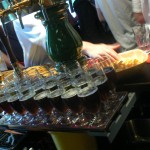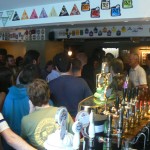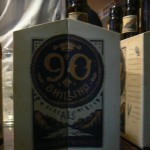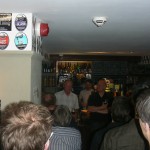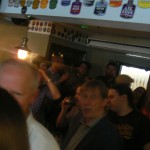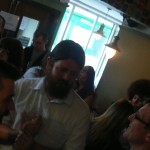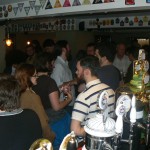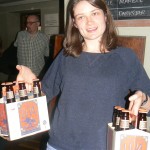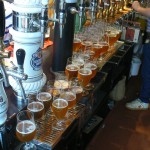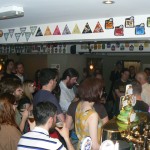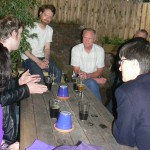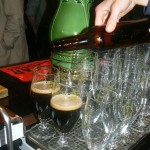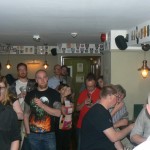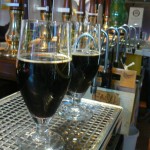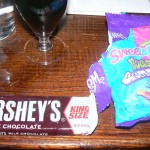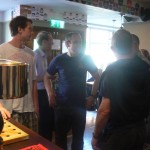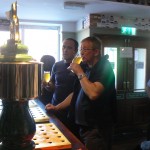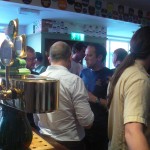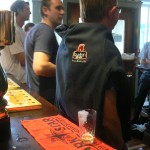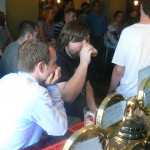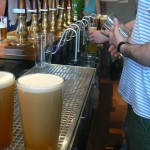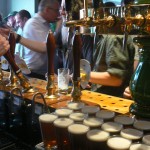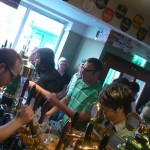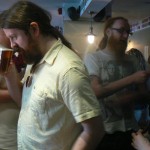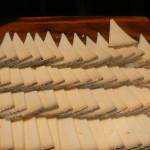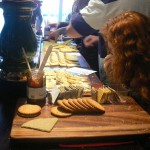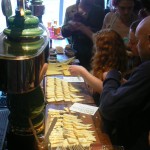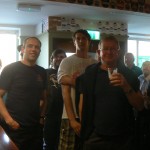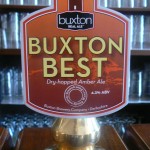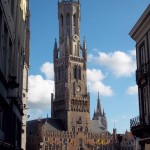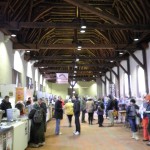
– Photos / Meet The Brewer with Doug Odell – Monday 11th June
Fresh from his trans atlantic flight, Doug Odell held court at this very intimate affair. The sold out crowd attentively listened to his every word as he talked about the history of the Odell brewery and introduced us to some amazing beers, including : 90 Shilling, IPA, Crimson Stout, Cutthroat and Aquitaine (Kirkstall collaboration).
Special thanks to all who came down and especially to Doug Odell and Andreas Fält for making this happen.

– Meet The Brewer with Camden Brewery / Monday 25th June 2012
£8 advance (tickets available from the bar or call 0161 237 9949)
SOLD OUT
It all started in The Horseshoe pub in Hampstead, North London, initially brewing cask ales beneath the pub before moving up out of the cellars and into the railway arches of Camden Town.
That was early 2010. Subsequently beautiful, German, ultra modern brewery was custom built and shoehorned into a series of railway arches, ideas became recipes and recipes became beers with the first beer going on sale in September 2010.
Inspired by classic European styles and modern American craft brewing, Camden Brewery bring a particular London sensibility to their beers, such as Camden Hells, Pale, Wheat and Ink, as well as special limited release beers throughout the year.

– Photos / Meet The Brewer with Buxton – Monday 28th May
The sun was out and the beer was flowing at yet another sold out event.
Buxton brewery brought their wonderful beers for us to sample, they included Imperial Black, Axe Edge, Wild Boar, Buxton Best and Moor Top. Buxton also gave everyone a leaving present in the form of a bottle of Tsar (Imperial Russion Stout), very tasty indeed.
Of course the evening wouldn’t be complete without some cheese! This was kindly supplied by the Hartington Cheese Shop.
Thanks to all who came down and especially Buxton brewery. Cheers!

– On Trend in Belgium / By John Clarke
Bruges Beer Festival (or Brugs Bier Festival to give it its Flemish name) has become on of the best in Belgium. It also enjoys one of the most spectacular venues of any beer festival you care to mention as it is held in a 13th Century beamed gallery inside the Halletorned – the bellower building that dominates the main square.
This year’s event, held over the first weekend in February, featured 74 breweries and beer firms and 322 beers. It was impossible to try everything and despite whittling my hit list down from 38 to 24 beers, I still didn’t manage to try everything that caught my eye. No matter, those beers I did try showed how the Belgian brewers are both maintaining their traditions but also adapting more international styles, but still managing to give them a Belgian twist.
So, here’s a quick canter through a few highlights (or not, as you will see). Troubadour beers were there with the full range including a brand new Imperial Stout (9%) which hit all the buttons as this firm’s beers usually do. The IPA-style Magma has already made some waves and I expect this to do the same,
Het Alternatief have already impressed me with some of their bigger beers, notably the double (or perhaps triple) IPA Bitter Waarheid (70EBU, 11%) and Imperial Stout Abetanterik (11%) but this year they had something that really split opinion, but also showed how willing to experiment some of the Belgian brewers now are. Onbekend en Onbemind (it means Unknown and Unloved) was a 10% sour ale that had spent six months in a burgundy cask. Did it work? Let’s just say opinion was very divided.
Another beer that missed the spot for me was Novice Tripel Black from Malheur. It was exactly what it said: a black tripel at 8.5%. It was surprisingly thin I thought and has a background aniseed taste that you find in some Belgian beers and that I really don’t care for. Staying on the downbeat theme, a much hyped outfit was Fort Lapin who by now will actually be brewing in Bruges. Their debut beer was Fort Lapin 8 which a fairly dull and disappointing tripel. Still, early day yet for them I think.
Another brewer with the urge to experiment is Den Triest who premiered three new beers. Green Hopping 2011 (6.5%) used fresh Belgian hops and while a good idea was a bit dull for me. Bitter Bock (6.5%) was a single hop beer using something from the States and was a really bitter beer with a huge long aftertaste. That was good but Indian 369 (7.5%) was a star turn. A bog bold IPA using a brand new and unnamed American hop. Excellent – and it is planned to be the first of a series, too.
Very new and a serious “one to watch” are Brouwers Verzet. Three young brewers whose style perhaps takes some inspiration from our own “friends in the north” (you know who I mean) their website is at least free from the liberal use of “graaf”* and the three beers they presented at Bruges made quite an impression. Rebel Local (8.5%) can best be described as a restrained IPA. Fresh, hoppy and light bodied (but in a good way) this was dangerously drinkable. A small wooden cask on their bar dispensed Oud Bruin (6.5%). Matured for six months in oak casks this was flat, sour, very well made and very good indeed. Least successful of the three for me was Moose Blues (7.5%) a darker beer with a bitter aftertaste, it had some spiciness to it that didn’t do it for me.
Brouwers Verzet shared a bar with Vilegende Paard who had just the one beer – Prearis Quadrupel (10%) Another young brewer who won a Belgian homebrew competition with this beer in April last year and now makes it commercially. You can see why it won – astonishingly well made and enjoyable, it was one of the best beers I tried. Smooth and rich, while you could tell it was a strong beer it wasn’t overtly boozy. A classic.
De Ranke is one of the best breweries in Belgium and makes superbly assertive beer. Hop Harvest 2011 (6%) was lovely stuff and did exactly what it said on the bottle. On the next bar was Martin’s IPA (6.9%) which didn’t. If the beer was as fancy as the bottle it would be a winner but sadly once again proved the point that the fancier the bottle, the duller the contents.
One of the older established Belgian family brewers is Van Eecke best known for their Kapittel range of abbey beers and Poperings Hommelbier. The latter is usually cited as being quite a hoppy beer, which it may be by Belgian family brewer standards, but isn’t really. However the dry hopped version (7.5%) was a different matter entirely. A big bold hoppy bitterness made for another dangerously drinkable ale. Van Eecke were also selling Tremist, a 6% beer based on Hommelbier, which showed through in a notably hoppy aftertaste.
Among the impressive newcomers to the Belgian beer scene is Ron Mengeriks’s De Dochter van de Korenaar which is becoming increasingly experimental. Embrasse is a dark, stouty sort of beer but the peated, oak aged version (10%) was a real star turn which would hold its own in any craft beer bar in Europe. The same goes for Belle-Fleur (6%) a gloriously hoppy IPA with six kilos of six different hop varieties and three kilos of dry hopping in each 1,000 litre brew. I also managed to try an advance taste of the new Charbon (7%), a slightly smoked, vanilla infused dry stout – superb. On the subject of this brewery, try and seek out L’Enfant Terrible (7%) an excellent lambic-ale blend.
De Leite is a relative newcomer, having been brewing commercially since 2008. Good, solid but fairly safe, commercial beers seems to be the byword, However Cuvee Mam’zelle (8.5%) was a real surprise. It’s matured in oak Medoc casks producing a rich, slighty sweet, smooth and seductive beer. I made the point of bringing some of this back with me.
While the festival has a dedicated lambic bar, one or two producers also have stands of their own. One such was the De Cam lambic blenders of Gooik. De Cam beers are usually harder to find than those of the other lambic makers and it was a treat to try the range. New was Oude Faro (5%) which immediately hit the spot. Now, faro is traditionally a sweetened draught lambic. This was bottled and beautifully sour – an all-night drink.
Dany de Smet makes his Slaapmutske beers at the Proef Brewery but they are none the worse for that. His beers are always a treat and the reformulated Dry Hopped Lager (5.3%) now made using Saaz hops was excellent – it was in fact the first beer I had at the festival and made for a good, quenching introduction. My second beer of the festival was rather different. Dany has recently stated the Slaapmutske Hop Collection, a series of beers made with a single variety. The first is made with East Kent Goldings, but lots of them to balance out the 10% ABV. This beer really does hide its strength very well. Too well. Dany is hoping to make a return visit to Manchester later this year, too.
Finally, Eutropius. I don’t know much about the history of these people. I do know they seem to have been around for some time but now occupy the premises vacated by Alvinne in Heule when they moved on, and are now making their own beers. First Angel (8.5%) is a blond beer which is fresh and hoppy. “Not at all bad” read my less than full tasting notes. Winter Heerlijkheid (8.5%) had sage in it. I only tried a taste and came away unimpressed. Then there was Vinkenier (10.8%), which was my final beer of the festival. I did not end on a high note – again my “tasting notes” for once say it all – “ sweet and horrible, worst beer of the festival”. Luckily the cafes of Brugge beckoned.
Next year the Brugs Bier Festival is on 2 and 3 February. Plans for my visit are already in hand.
Words by John Clarke / Chariman of South Manchester CAMRA and Editor of Opening Times.



